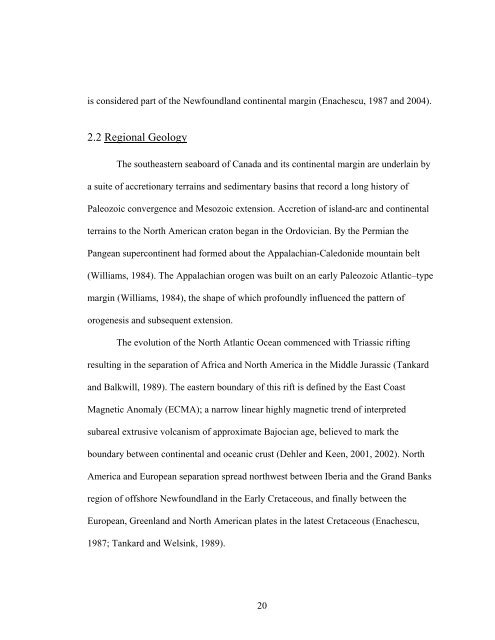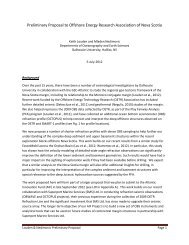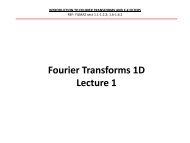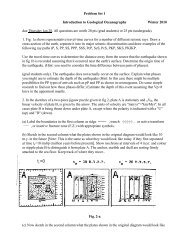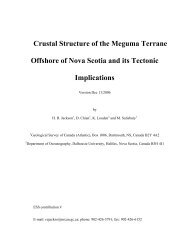- Page 1 and 2: THE STRATIGRAPHY AND STRUCTURAL HIS
- Page 3 and 4: The integration of seismic stratigr
- Page 5 and 6: leaving his door open and helping m
- Page 7 and 8: 3.3.4 Tr2 Sequence Boundary 57 3.3.
- Page 9 and 10: List of Figures (Short Titles) 1-1
- Page 11 and 12: 3-22 Time structure map of the T1 S
- Page 13 and 14: 5-17 End member geometries of alloc
- Page 15 and 16: Chapter 1 Introduction 1.1 Introduc
- Page 17 and 18: developed in the western part of th
- Page 19 and 20: Areomagnetic surveys of the North A
- Page 21 and 22: y Mukhopadhyay and Wade (1990), Wil
- Page 23 and 24: 9 Figure 1-2: Comparative stratigra
- Page 25 and 26: Naskapi N-30 Figure 1-3: Map showin
- Page 27 and 28: SE NW 0 6 12 Kilometers 13 Figure 1
- Page 29 and 30: converted using velocity informatio
- Page 31 and 32: to date the effects of salt tectoni
- Page 33: A 19 A’ Figure 2-1: Bathymetry an
- Page 37 and 38: 23 Figure 2-3: Generalized lithostr
- Page 39 and 40: the landward extensions of regularl
- Page 41 and 42: marine shales of the Misaine Member
- Page 43 and 44: and positive relief structures on t
- Page 45 and 46: formation thickness consistently in
- Page 47 and 48: 2.4 Structural Styles and Geometry
- Page 49 and 50: and igneous rocks of the Meguma Ter
- Page 51 and 52: approximately 6 to 7 kilometers bel
- Page 53 and 54: 4.2.3 Halotectonics In addition to
- Page 55 and 56: 41 Figure 2-10: Scotian Margin base
- Page 57 and 58: NW SE 6126 m 43 Figure 3-1: Represe
- Page 59 and 60: TGS Base Tertiary Unconformity 45 T
- Page 61 and 62: 47 Figure 3-3: Lithoprobe seismic r
- Page 63 and 64: (Member Good DS9 Good Good Excellen
- Page 65 and 66: NW SE Onlap Downlap 0 6 12 Kilomete
- Page 67 and 68: 3.3.1. Top Basement Marker Within t
- Page 69 and 70: 3.3.2. Tr1 Sequence Boundary The Tr
- Page 71 and 72: 3.3.3 Depositional Sequence 1 Depos
- Page 73 and 74: Glooscap C-63 E Moheida P-15 D TWT
- Page 75 and 76: NW SE D D’ Eurydice Figure 3-9: S
- Page 77 and 78: Formation consists of a series of m
- Page 79 and 80: These reflections may represent int
- Page 81 and 82: Anomalous highs Sequence boundary i
- Page 83 and 84: in shape, 1 to 12 kilometers in dia
- Page 85 and 86:
Intersection with salt structure Fa
- Page 87 and 88:
62, also intersected the Abenaki Fo
- Page 89 and 90:
marker in a landward direction (Fig
- Page 91 and 92:
south (slope-parallel) direction. T
- Page 93 and 94:
3.3.13 Depositional Sequence 5 Depo
- Page 95 and 96:
Thickness TWT (ms) D D’ Thick Int
- Page 97 and 98:
NW SE Quaternary Miocene - Oligocen
- Page 99 and 100:
Due to the consistently high amplit
- Page 101 and 102:
Correlation with the Shubenacadie H
- Page 103 and 104:
3.3.17 Depositional Sequence 7 Depo
- Page 105 and 106:
3.3.18. T2 Sequence Boundary The T2
- Page 107 and 108:
Reflections within DS8 are commonly
- Page 109 and 110:
3.3.20 T3 Sequence Boundary The T3
- Page 111 and 112:
3.3.21 Depositional Sequence 9 Depo
- Page 113 and 114:
3.3.22 Water Bottom The uppermost r
- Page 115 and 116:
4.1 Introductory Remarks Chapter 4
- Page 117 and 118:
A (TWT ms) Basin-Bounding Fault Fam
- Page 119 and 120:
A A’ NW SE 105
- Page 121 and 122:
4.2.1 Slope Basin-Bounding Fault Fa
- Page 123 and 124:
Figure 4-3: Seismic Profile B-B’
- Page 125 and 126:
Wernicke (1981) or “second-order
- Page 127 and 128:
a) 2.0 3.0 4.0 5.0 6.0 7.0 8.0 b) D
- Page 129 and 130:
T3 T2 T1 T0 K1 J2 J1 Tr2 Tr1 NW SE
- Page 131 and 132:
thickening, resulting in distinct w
- Page 133 and 134:
Tertiary. In the northwest some maj
- Page 135 and 136:
SE NW Minor Faults 3076 m Major Fau
- Page 137 and 138:
NE SW 3075 m Pock-Marks ? Erosion E
- Page 139 and 140:
Chapter 5 Salt Tectonics 5.1 Mechan
- Page 141 and 142:
as a pressurized fluid with differe
- Page 143 and 144:
shales related to rapid progradatio
- Page 145 and 146:
131 Figure 5-3: Tectono-stratigraph
- Page 147 and 148:
Shelf N 0 15 30 Kilometers Moheida
- Page 149 and 150:
Shelf N 0 15 30 Kilometers Upper Sl
- Page 151 and 152:
A) NW SE B) Swells Normal basement-
- Page 153 and 154:
Salt Detachment Association includi
- Page 155 and 156:
formed shortly after autochthonous
- Page 157 and 158:
and Vendeville (1994) shows that th
- Page 159 and 160:
Allochthonous Stock “Finger” Di
- Page 161 and 162:
A’ SE A Folding of strata from T0
- Page 163 and 164:
Diapirs commonly intersect the K1 S
- Page 165 and 166:
D’ SE NW D 0 3 6 Strata folded fr
- Page 167 and 168:
Figure 5-14: Diapir rejuvenation du
- Page 169 and 170:
5.3.4 The Secondary Weld Associatio
- Page 171 and 172:
NW SE 0 3 6 Kilometers Inclined Sec
- Page 173 and 174:
An allochthonous salt structure is
- Page 175 and 176:
Salt Stocks A salt stock is charact
- Page 177 and 178:
F’ NE SW F 0 6 12 Kilometers Coal
- Page 179 and 180:
G (A) (B) G’ Figure 5-20: (A) Nor
- Page 181 and 182:
Figure 5-21: Schematic evolution of
- Page 183 and 184:
listric fault, causing the developm
- Page 185 and 186:
egardless of depositional setting a
- Page 187 and 188:
growth will continue until the sour
- Page 189 and 190:
Salt structures with onlapping syn-
- Page 191 and 192:
the base of post-kinematic stratigr
- Page 193 and 194:
SE NW 4093 m 179 Offset of paleo-de
- Page 195 and 196:
NE SW 6 km 181 Turtle Structure Pos
- Page 197 and 198:
NE SW 183 0 3 6 Turtle Structure Ki
- Page 199 and 200:
Figure 6-1: Seismic profile from th
- Page 201 and 202:
Figure 6-2: Tectono-stratigraphic c
- Page 203 and 204:
Ordovician metasedimentary rocks of
- Page 205 and 206:
191 Figure 6-3: Schematic block dia
- Page 207 and 208:
etween the location of salt swells
- Page 209 and 210:
On the slope, the Late to Middle Ju
- Page 211 and 212:
Listric growth faults typically tip
- Page 213 and 214:
this diapiric region. However, it w
- Page 215 and 216:
characteristically concordant with
- Page 217 and 218:
typical of passive margins modified
- Page 219 and 220:
Slope Basin: Kidston et al. (2002)
- Page 221 and 222:
~ Present day 100 C ~ Present day 1
- Page 223 and 224:
area can be divided into three slop
- Page 225 and 226:
Pre-Mesozoic structures are not con
- Page 227 and 228:
eservoir. The well locations were c
- Page 229 and 230:
7.2 Key Conclusions Geological Evol
- Page 231 and 232:
exclusively deform Late Triassic to
- Page 233 and 234:
• A reservoir of Cretaceous to Te
- Page 235 and 236:
References Alsop, G. I., Brown, J.P
- Page 237 and 238:
Gauley, B. J., 2001, Lithostratigra
- Page 239 and 240:
Keen, C. E., and Potter, D. P., 199
- Page 241 and 242:
Scotian Rise, Geological Survey of
- Page 243:
Welsink, H.J., Dwyer, J.D., and Kni


